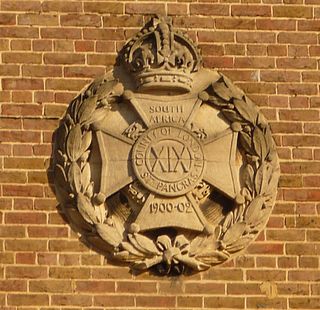
The 301st Infantry Brigade was a formation of the British Army organised from surplus Royal Artillery (RA) personnel retrained as infantry towards the end of the Second World War.

The 304th Infantry Brigade was a formation of the British Army organised from surplus Royal Artillery (RA) personnel retrained as infantry towards the end of the Second World War.
The 305th Infantry Brigade was a formation of the British Army organised from surplus Royal Artillery (RA) personnel retrained as infantry towards the end of the Second World War.
306th Infantry Brigade was a British Army formation organised towards the end of the Second World War from surplus Royal Artillery (RA) personnel who had been retrained as infantry.
307th Infantry Brigade was a formation of the British Army organised from surplus Royal Artillery (RA) personnel retrained as infantry towards the end of the Second World War.
308th Infantry Brigade was a formation of the British Army organised from surplus Royal Artillery (RA) personnel retrained as infantry towards the end of the Second World War.
27th Anti-Aircraft Brigade was an Air Defence formation of the British Army in World War II that served in The Blitz and later converted to infantry.

The 19th Battalion, London Regiment was a Volunteer unit of the British Army in existence from 1860 to 1961 under various titles. A detachment served in the Second Boer War and two full battalions fought in World War I, receiving the surrender of Jerusalem and crossing the Jordan among other exploits. During World War II the regiment operated as a searchlight unit and briefly as an infantry battalion, before becoming an anti-aircraft regiment in the postwar years.

The 36th (Middlesex) Searchlight Regiment was a volunteer air defence battalion of Britain's Territorial Army (TA) from 1936 until 1961, at first as part of the Royal Engineers, later in the Royal Artillery. As part of 40th Anti-Aircraft Brigade it defended air bases in East Anglia through the Battle of Britain and the Blitz. Towards the end of 1944 the unit underwent infantry training, serving briefly in Norway at the end of the war. After the war, the 36th continued as a TA unit, with some women serving with it. In 1961, the remnants of the regiment amalgamated with others to form a combined infantry battalion, and all links with air defence were severed.
29th Anti-Aircraft Brigade was an air defence formation of Britain's Territorial Army (TA) before and during World War II. It defended East Anglian airfields and ports during the Battle of Britain and The Blitz. It was reformed in the postwar TA.
The 38th Light Anti-Aircraft Brigade was an air defence formation of Britain's Territorial Army formed just before World War II, which protected London and Southern England during the Blitz and later converted into an infantry formation for the liberation of Europe.
The 30th (Northumbrian) Anti-Aircraft Brigade was an air defence formation of Britain's Territorial Army from 1936 until 1955, which defended Tyneside and Sunderland during World War II.
The 31st Anti-Aircraft Brigade was an air defence formation of Britain's Territorial Army from 1936 until 1948. During World War II it defended West Yorkshire and later participated in the North West Europe campaign.
58th (Middlesex) Searchlight Regiment, Royal Artillery was an air defence unit of Britain's Territorial Army (TA) raised just before World War II. It defended the East Midlands of England during The Blitz, and later served as infantry in North West Europe at the end of the war, converting to the anti-aircraft (AA) artillery role postwar.
The 40th Anti-Aircraft Brigade was an air defence formation of Anti-Aircraft Command in the British Territorial Army (TA) formed shortly before the outbreak of World War II. Its initial role was to defend Royal Air Force (RAF) airfields in East Anglia. Later it commanded part of the searchlight belt protecting The Midlands. In 1944 the brigade was moved south to protect the embarkation ports for Operation Overlord and to defend against V-1 flying bombs in Operation Diver. It was briefly reformed in the postwar TA.

48th (Hampshire) Searchlight Regiment, Royal Artillery was an air defence unit of Britain's Territorial Army (TA) formed just before the outbreak of World War II from existing searchlight companies of the Royal Engineers. It served in Anti-Aircraft Command until 1944, including the Portsmouth Blitz and Operation Diver. At the end of the war it formed an infantry unit for garrison duties in liberated Europe. It continued in the postwar TA until AA Command was disbanded in 1955.
The 6th Battalion, Essex Regiment was a volunteer unit of Britain's Territorial Army. First formed in the docks of East London in 1860, it served as infantry at Gallipoli and in Palestine during the First World War. It later formed searchlight units of the Royal Artillery (RA), serving during the Blitz.

The 51st (Highland) Searchlight Regiment, Royal Artillery was a Scottish unit of Britain's Territorial Army (TA) formed for air defence just before World War II. It later served as an anti-aircraft (AA) artillery unit in the North West Europe Campaign 1944–45, and continued in the postwar TA into the 1950s.

The 4th Anti-Aircraft Division was an air defence formation of Britain's Territorial Army, created in the period of tension before the outbreak of the Second World War. It defended North West England during the Blitz.
68th Searchlight Regiment was a part-time air defence unit of Britain's Territorial Army converted from an infantry battalion just before World War II. It served in Anti-Aircraft Command defending the West of England until almost the end of the war, when it was converted back into an infantry battalion for occupation duties in North West Europe. Postwar it served on in the air defence role until the disbandment of AA Command in 1955.





